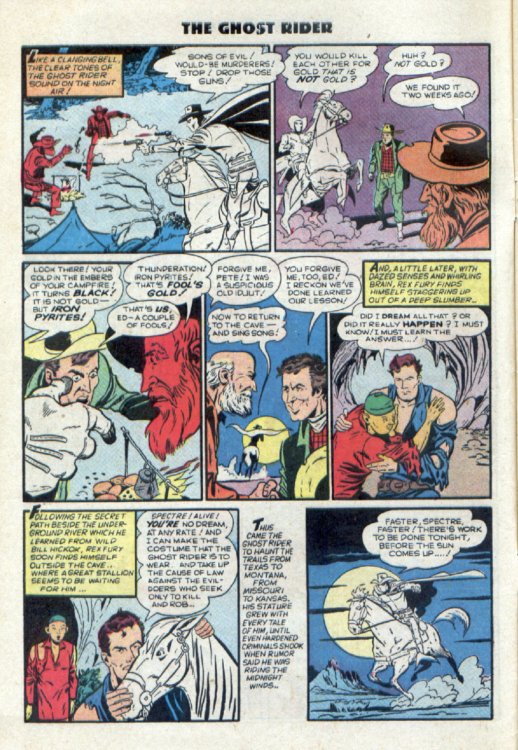WARNING: Stereotypes of Native Americans and Asians common to the 1950s. May be NSFW.
From Ghost Rider #1 (1950). Written by Ray Krank. Penciled and inked by Dick Ayers.
He began life in the late 1940s as
Rex Fury, aka
The Calico Kid, a masked hero whose secret identity was a lawman who felt justice was constrained by legal limitations. (There were a
lot of those heroes in comics and pulps of the 40s including our own
DareDevil and
Blue Beetle!)
But, with masked heroes in
every genre doing a slow fade-out after World War II, and both the western
and horror genres on the rise, the character was re-imagined in 1949 as comics' first horror / western character!
The Ghost Rider himself was
not a supernatural being.
He wore a phosphorescent suit and cape, making him glow in the dark, appearing as a spectral presence to the (mostly) superstitious cowboys and Indians he faced.
Since the inside of the cape was black, he'd reverse it, and appear in the dark as just a floating head, usually scaring a confession or needed information out of owlhoots.
Despite the initial aid from deceased Western heroes (and a heroine) in this origin tale, the series' early days were populated with villains who were standard owlhoots or, like
The Ghost Rider, people
pretending to be supernatural beings.
That changed around 1952, when he started facing
real mystic menaces including zombies.
Unfortunately, it was about this point in time that Dr. Wertham began his crusade against comics in general and horror comics in particular...
By 1954,
the Ghost Rider had lost his series. The next year he disappeared entirely.
In the late-1960s, Marvel Comics was about to expand their line and decided to take several long-unused character names (including
Captain Marvel and
Phantom Eagle) and apply them to
new characters.
They also revived
Ghost Rider, illustrated by the original version's artist, Dick Ayers, and with the
same costume and gimmicks! (At least they changed the secret identity and origin.)
He only lasted a year or so in his own title, but he's been showing up as a guest-star at Marvel ever since, under the names
Night Rider or
Phantom Rider, since the
Ghost Rider name was usurped by a motorcycle-riding supernatural hero in 1973.
Eventually, the Western hero was given a supernatural background as well, which resulted in his appearing in the
Ghost Rider movie...
Ironically, the writer of the Marvel Western hero, Gary Friedrich, was the co-creator (with Mike Ploog) of the modern motorcycle rider, just as Dick Ayers was the co-creator/illustrator of
both Western versions!
But, over 50 years later,
Atomic Kommie Comics™ brought the
original version back back, digitally-restored and remastered on a host of kool kollectibles to go with our other
masked Western heroes including
The Lone Rider,
The Red Mask,
The Black Phantom, and
The Masked Ranger.



















































